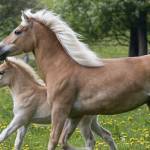“Lead Mare” Position May Not Exist in All Horse Herds

The position of “lead mare,” an older female that makes decisions about herd movement, may not be a universal feature of wild horse groups, according to research carried out in Italy.
The lead mare theory maintains that although a high-ranking stallion is in charge of herd safety and security, an “alpha” mare decides where the herd will graze and when they will visit a water source.
In the recent study, three herds of feral horses were observed in several sessions totaling 15 hours for each group. Examples of herding behavior (one horse drives others ahead of it) and departure behavior (one horse leaves the group and others follow it) were noted. In all cases, only stallions exhibited herding behavior. Departure behavior was seen in mares of both high and low social rank, suggesting that leadership may be a shared duty among many horses in the herd, depending on the situation.
The researchers related their results to training methods in which the trainer seeks to take on the lead mare role. They suggested that because this position may not exist universally in horse herds, trainers might not succeed in becoming the figure that another horse wants to follow. Horses can be trained to do what a trainer asks them to do, but it may not be a result of instinctive desire to accept leadership from one dominant individual.








